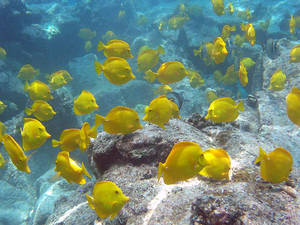A new study shows for the first time that Marine Protected Areas (MPAs) can benefit surrounding areas of sea by supplying fish larvae that drift out and re-seed areas over 100 miles away. Scientists found this out using a brand new DNA fingerprinting technique similar to forensic technologies used in human crime cases.
The drifting of larvae out of MPAs is a really important plus side for them, but it's something that until now we've had to assume because there's been little direct evidence to show that it actually happens.
 Mark Christie from Oregon State university led a team who studied a beautiful reef fish called a Yellow Tang. These fish were in serious decline in Hawaii a decade ago because they were taken in huge numbers for the aquarium trade, until 9 MPAs were set up to help protect them.
Mark Christie from Oregon State university led a team who studied a beautiful reef fish called a Yellow Tang. These fish were in serious decline in Hawaii a decade ago because they were taken in huge numbers for the aquarium trade, until 9 MPAs were set up to help protect them.
Yellow Tang are perfect for studying how fish larvae disperse because once they settle down on a reef they stay put, living within a half-mile home range. So, if a juvenile ends up a long way from its parents, the only way it could have got there is by drifting as a tiny larvae, not by swimming when it was older.
The researchers analysed the genetics of over 1000 juvenile and adult fish in Hawaii and using this new fingerprinting technique matched up offspring to their parents, uncovering that a few young fish ended up on a different reef up to 114 miles from mum and dad. And where they ended up corresponded to with a prevailing northward ocean current.
This is just one species of fish, and there will be many different things going on within a whole ecosystem. But this sort of detailed information is vitally important for the creation of effective marine protected areas, because it helps us to work out where best to put MPAs to maximise the connections between different sites. This should also help encourage ocean users to support MPAs and stick to the rules of not fishing inside them, the idea being that fisheries beyond the MPA can benefit too as well as fish inside the reserve.
As the authors write in their paper, in the journal Plos One, it goes to show the important linkages between different areas of the sea, and that management in one part of the ocean affects people who use the sea elsewhere.
Find out more
Mark Christie et al. (2010). Larval Connectivity in an Effective Network of Marine Protected Areas .
PLoS ONE
Yellow Tang (Zebrasoma flavescens) on
Fishbase










Comments
Add a comment